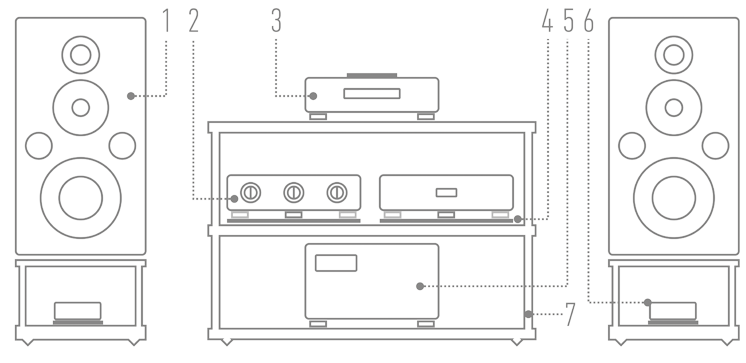|
Loudspeakers | Floorstanders AudioSolutions
Manufacturer: AUDIOSOLUTIONS |


|

|

The Rhapsody 60 and 80 loudspeaker models were characterized by a sophisticated artistic design. One must admit that there are not too many companies that can offer such well thought-out design, acoustic construction and perfect craftsmanship from the start. It was enough to have a look at the products to know that something important was being born and that it would become an important point on the audiophile map, if, of course, the company would survive the first few years. And? And now it is better than one could have expected, even based on an optimistic forecast. The company now offers a range of the best technologies that are currently used in loudspeakers equipped with classic drivers. | FIGARO M The Figaro M loudspeaker model that we are testing here looks fantastic. Without doubt, it could carry the logo of Sonus faber or some other large and well-known company, as it represents a similar level of craftsmanship. It must also be remembered that the AudioSolutions company has been making almost all the elements of its columns by itself – it was like that at the beginning and it is so now. The Figaro series was created on the basis of experiences gathered during work on the Rhapsody series. However, the new loudspeakers are much more technologically advanced, but cheaper. Their direct point of reference are, as the manufacturer claims, loudspeakers from the more expensive Overture series and the Vantage 5th Anniversary loudspeakers. Marek wrote more about the technologies used in the Figaro series when we tested the Figaro S model, so I will only repeat the most important things. Technology | The most impressive element is the form of the loudspeakers. They are really robust and their panels are made of different materials. The base is not a classic rectangle but a hexagon, in order to strengthen the cabinet mechanically and reduce standing waves. Their mechanical design is a little different from what is usually used and the technique has been called Self-Locking. The thing is that the joints between individual elements are pressed and not moved. It is similar in the case of monolithic cabinets. The loudspeakers are really large: 1120 x 272 x 470 mm. Their cabinets are characterized by a sandwich design and they dampen resonances well. According to the company materials, thanks to this it was possible to reduce the weight by 50 to even 70%, retaining the same mechanical properties. In spite of that, the loudspeakers are heavy – they weigh 45 kg (per unit). There are 17 different finishes available to be applied to their side panels and all the color versions are included in a special palette. One can also decide what the front panel will look like. It might have a grille or an element that will make the front more rigid. The company calls this solution the Stealth Grille. As far as acoustics is concerned, the Figaro M is a three-way loudspeaker with four drivers and a bass-reflex cabinet. For the treble, there is a 25 mm dome with a silk membrane, inserted into a short horn. The mini-horn, as this is the name the company has given to the solution, is designed to improve the directional characteristics of the driver. It is a design characterized by a reverse configuration, as the 152 mm midrange driver is located above the tweeter. It has a membrane made of cellulose with additions – and this solution is called the ER, i.e. Extra Rigid. Two woofers have a similar membrane, but with a ø 183 mm diameter. The midrange driver operates within a very broad range, i.e. from 400 Hz to 4000 kHz, while it is normally cut off already at 1.5-2.5 kHz. I assume this is to help retain effective human voice processing. Let me add that the dome, which is smaller than usual, is also faster – its diameter size may result from the higher cut-off point. As you have probably already noticed after the short introduction, it is a well-thought-out design including a lot of the company’s own original solutions. Signal is transmitted to the loudspeaker through single WBT connecting terminals from the Nextgen series, made of pure copper. They are mounted on a metal plate very close to the floor. This helps us install heavy cables that may be shorter because of that. However, such a low position of the terminals causes problems when it comes to connecting rigid cables with fork terminals – banana plugs are much better for the purpose. The loudspeakers are not placed on spikes, but on four feet that are part of an anti-vibration system. This solution has been borrowed straight from the enormous Vantage 5th Anniversary loudspeakers. | THE WAY WE LISTENED The Figaro M loudspeakers are fairly slim. However, that does not change the simple fact that they are quite large and heavy. So, I had to move my Harbeth M40.1 loudspeakers and put them next to another wall, and place the AudioSolutions loudspeakers at exactly the same spot. The distance between their tweeters was 230 mm, while the distance between their rear panel and the wall was 60 cm. They were directed straight towards the listening spot. What is important here is the height of the listener as compared to the location of the drivers – with such a configuration, the most coherent sound is obtained when the listener’s ears are at the level of the midrange driver. The loudspeakers cooperated with the “High Fidelity” reference system, but for a moment I also listened to them with the Simaudio by MOON 860A v2 power amplifier which replaced the Soulution 710.  Recordings used for the test (a selec- tion)

One of the things I do after placing new loudspeakers in my room is listening to a few monophonic records. I almost always start with Frank Sinatra, as there is a beautiful vocal and a great large swing orchestra. Then I usually listen to Nat “King” Cole’s recordings from the period when he was not a vocalist yet, but performed as a pianist – the role he truly identified himself with. The choice of a monophonic recording seems fairly obvious to me – I want to set up the loudspeakers in a way that will direct the image, i.e. the sound projection, straight onto me, enclosed within the loudspeaker frames. The end result is always different. There are loudspeakers that cannot be forced (using any setup) to produce concentrated mono sound. The AudioSolutions Figaro M loudspeakers not only “clicked” immediately, but also presented extremely focused and excellently defined sound. In the past, I had not been able to obtain such high-quality sound from monophonic recordings too often. Sinatra’s vocal from the Songs for Swingin’ Lovers! album on the Mobile Fidelity Sound Lab reissue was situated right in front of me and it took up quite a lot of space, but was also well-defined. The depth was presented exceptionally well, with each further layer differing in size – the further away, the smaller the image was; tone color – the further away, the lighter and dynamics (changing in the same way). 
Another thing that struck me was the absolute “disappearance” of the loudspeakers from the room. It is something that music lovers and audiophiles dream of. And here I got it already at the beginning, without any special setup efforts. Loudspeakers need to be set up precisely, which is obvious, but the differences between a better and a worse setup are not overwhelming. However, there is also a moment when everything “clicks” together and we know that this is the place and the setup. |

Such a level of stereophony, but in the primary sense of the word, i.e. “spatial” sound, is usually obtained when standmount speakers are used. It is due to the fact that they are not small enough for wave deflections on the edges to be negligible, while their cabinets are rigid enough not to affect the sound image. The cabinet of the tested loudspeakers is so well-developed and their drivers are so well-integrated that the loudspeakers disappear more effectively than most of the standmount loudspeakers (even very expensive ones) that I have ever had in my system. When I listened to Sinatra, I could already hear that these are loudspeakers in which the most important range is the midrange. However, they are also tuned in a way that prevents them from affecting sound as much as it is possible. These two things seem to be mutually exclusive, but not here – here they complement each other. Both Sinatra’s and Cole’s vocals (one cannot deny it – he was also an extremely good vocalist) were full and dense. However, they were also pure and lacked coloring. When I talk about the focus on the midrange, I mean something else than what I write about with reference to Spendor, Harbeth (e.g. my M40.1 model) or even Chario loudspeakers. As regards all the above-mentioned loudspeaker groups, the saturation and fullness of vocals is obtained by emphasizing a certain part of the lower midrange and higher bass. Thanks to this, a small sub-range responsible for the “fullness” is highlighted a little. It is done professionally and successfully, and it is something I am attached to. However, in his Figaro M model, Mr Gediminas Gaidelis shows us that it can be done in a different way. Thus, he comes closer to such designs as the YG Acoustics Carmel 2, i.e. closer to neutrality. It is an advantage for these loudspeakers – they do not go into this direction more than it is necessary. It is because their color palette is incredibly rich. It is true that they are not too generous when it comes to giving us the “connective tissue”. However, they neither reduce it, nor make the sound dry up. These loudspeakers show the richness of colors in such a fair way that many other equally good designs seem colored when compared to them. The Figaro M play any music steadily and accurately, retaining sound fill and depth. 
It might seem that such precise designs will be problematic when it comes to treble. That may be the case with some other loudspeakers, but not these ones, not in such a meticulously developed product. In order to check it, I listened to the Tower Records SACD version of Chick Corea’s Return To Forever, as it is “flat transfer” from analog tape. There is a lot of noise, which instantly eliminates all the products that emphasize this part of the range – it is then bright and dominant. What I heard with the Figaro M loudspeakers was even better than what is shown by the Harbeth M40.1 model whose tweeter is not that precise. It is more saturated, but not so accurate. The Lithuanian loudspeakers showed these recordings in a fantastic and very colorful way, with outstanding dynamics and a great sense of rhythm. However, that was more like the subdued colors of Art Deco and Alfons Mucha than the wild world of Frida Kahlo. As for the tested loudspeakers, the character of the bass was already visible when I listened to Sinatra, it was then more emphasized with Corea’s album and most fully revealed on Patricia Barber’s album Companion, in the track entitled Sue Me. It begins with a double bass solo – the instrument is a little tuned up and sound is collected close to it, perhaps even using a contact microphone (I am not sure about that). The AudioSolutions loudspeakers showed the character of the instrument very well, but I also knew instantly that they did not aim to lower the sound to a maximum degree or pull the bass at any price. In an interview that I conducted with Mr Gaidelis in 2012, he said that he tunes his designs a little higher than the woofer’s own resonance and that the cabinets are a little larger than the technical parameters of the drivers might suggest. Now I can hear better than before why he does so. Thanks to this, he obtains excellent signal speed with really good fill. These loudspeakers play music like closed designs, but without the “box” at the bottom of the scale that is a little hollow and needs to be accepted. Barber’s vocal is shown quite close to us on the album, as the microphone was placed really close to her, right next to her lips. So, the tested loudspeakers only showed that feature of the acoustics and one of the sound engineering secrets. When the vocalist is situated further away, like Sinatra and Cole, the vocal is a little further away and it is a little smaller. Perhaps this is why the loudspeakers define the depth of the stage so well? Anyway, they not only precisely define its depth, but also width. However, they neither do it in an ostentatious manner, nor boast about sound planes or instruments within our reach, or enchant us with a base that is as wide as a wagon. When we do not focus on this aspect of sound, we will really hear it this way, but as some secondary feature accompanying the music and not something that attracts our attention. It is because, although these are incredibly accurate and precise devices, they do not place technology before music. If we want to weigh them down, let us listen to them with some warmer tube amplifier – e.g. the Leben CS-600X – and we will hear everything I am talking about plus a little warmth. It will be a coloring, but one resembling chocolate poured at the bottom of the cone at the Good Lood ice-cream shop. It is just a small addition, but it changes the overall picture. | CONCLUSIONS It has been a long time since I heard other loudspeakers that could be listened to with such ease. You do not have to make any effort with them or convince yourself to accept anything. The loudspeakers are precise, neutral, incredibly dynamic and have a sophisticated tone color. However, some people might lack some weight or filling in solid images a little. That is fine, as, in the end, these are not the best loudspeakers in the world, so it would be strange if they did everything equally well. However, for 20,000 PLN we will get something that is so good that we might stop searching at all and focus on listening to music. OK, I am not going to lie – we will focus on listening to music, but only after we have changed (for the very last time – I promise!) our source, cables and amplifier. RED Fingerprint for the design, craftsmanship and sound – the Figaro M loudspeakers really deserve it!  The cabinet | The Figaro M loudspeakers made by the Lithuanian AudioSolutions company are an example of how to prepare technologically advanced, well-thought-out and excellent-sounding products using commonly available techniques, materials and subassemblies. Let us start with the cabinet, as it is an incredibly advanced structure. The base is a hexagonal box made of plywood assembled in a way that makes the walls come really close together. MDF boards are added onto the walls from the outside and they are externally visible. There is also some damping material between these two layers, but not everywhere, just at a few selected places. The aim is to make the loudspeaker mechanically rigid, but not “dead”. The main solid, i.e. the upper part, bottom, part of the sides and back are covered with durable varnish containing glittering silver particles. Thanks to this, the loudspeaker is optically lighter. The sides are available in different finishes, from varnish (including 3D textured high gloss finishes) to natural veneer. The whole cabinet stands on four feet integrated with the loudspeaker. The feet are mechanically decoupled, but they allow the user to move the heavy loudspeaker without worrying about the floor surface. The feet can be hide inside the base a little, so the loudspeaker seems to stand directly on the floor, but it really does not. The grille | The aesthetics of the Figaro M loudspeakers is improved without impairing their acoustic properties, thanks to the original grille idea. It is almost always something “imposed”, added to the main solid – it usually does not look too good and almost always has a detrimental effect on sound, as sound is reflected from the grille frames. The idea that the AudioSolutions company has come up with is called the Stealth Grill. The front panel is profiled they way it used to be done in the past – i.e. all the panels stick out at the front. This normally leads to sound refractions and reflections, but here it is different. If we do not use the grille, we put an MDF board panel there and it comes flush with the front panel. It is similar in the case of the grille, but the whole thing is covered with black cloth. To ensure free sound flow, the front of the tweeter dome protrudes from the front wall when neither the grille nor the MDF board are placed there. After either of them is applied onto the front panel, the dome ideally comes flush with them. 
The design | As far as the electrical aspect of the design is concerned, these are three-way, four-driver loudspeakers. The fairly short bass-reflex vent is located on the rear panel. One of the most important technologies owned by the AudioSolutions company is the way they make the crossover. We can read in the so-called “white paper”, which I received from the manufacturer, that the crossover is mounted onto a printed circuit board with thicker paths. In the earlier series, the elements were soldered to one another, but after the company has found a suitable sub-supplier, it decided to change that. There are certain disadvantages and advantages of such a solution and the company mentions two benefits: ideal product reproducibility and pairing. Crossovers are also paired, so that both loudspeakers in a pair sound the same. Top-class Jentzen MKT capacitors and coils with a thick winding wire, immersed in resin, are used in them. The resin eliminates micro-vibrations affecting sound transmission. Toroidal coils (similar to the ones used in YG Acoustics loudspeakers) characterized by low losses are used in the woofers. Signal is transmitted to the loudspeakers through WBT connecting terminals from the Nextgen series, i.e. ones having thin copper contacts. These are wonderfully prepared and well-thought-out loudspeakers – both mechanically and electrically. ■  Technical specifications (according to the manufacturer): Sensitivity: 91.5 dB (2.83 V/1 m)Nominal power handling: 140 W Maximum unclipped power handling: 280 W Nominal impedance: 4 Ω Crossover frequency: 400 Hz | 4000 Hz Frequency response (in-room environment): 32 – 25 000 Hz Dimensions (HxWxD): 1120 x 272 x 470 mm Weight: 41 kg each |

|
Reference system 2018 |
|
 1) Loudspeakers: HARBETH M40.1 |REVIEW| 2) Line preamplifier: AYON AUDIO Spheris III Linestage |REVIEW| 3) Super Audio CD Player: AYON AUDIO CD-35 HF Edition No. 01/50 |REVIEW| 4) Stands (loudspeakers): ACOUSTIC REVIVE (custom) |ABOUT| 5) Power amplifier: SOULUTION 710 6) Loudspeaker filter: SPEC REAL-SOUND PROCESSOR RSP-AZ9EX (prototype) |REVIEW| 7) Hi-Fi rack: FINITE ELEMENTE Pagode Edition |ABOUT| |
|

|
Cables Analog interconnect SACD Player - Line preamplifier: SILTECH Triple Crown (1 m) |ABOUT|Analog interconnect Line preamplifier - Power amplifier: ACOUSTIC REVIVE RCA-1.0 Absolute-FM (1 m) |REVIEW| Speaker cable: SILTECH Triple Crown (2.5 m) |ABOUT| |

|
AC Power Power cable | Mains Power Distribution Block - SACD Player: SILTECH Triple CrownPower (2 m) |ARTICLE| Power cable | Mains Power Distribution Block - Line preamplifier - ACOUSTIC REVIVE Power Reference Triple-C (2 m) |REVIEW| Power cable | Mains Power Distribution Block - Power amplifier - ACROLINK Mexcel 7N-PC9500 |ARTICLE| Power cable | Power Receptacle - Mains Power Distribution Block: ACROLINK Mexcel 7N-PC9500 (2 m) |ARTICLE| Power Receptacle: Acoustic Revive RTP-4eu ULTIMATE |REVIEW| Anti-vibration platform under Acoustic Revive RTP-4eu ULTIMATE: Asura QUALITY RECOVERY SYSTEM Level 1 |REVIEW| Power Supply Conditioner: Acoustic Revive RPC-1 |REVIEW| Power Supply Conditioner: Acoustic Revive RAS-14 Triple-C |REVIEW| Passive filter EMI/RFI: VERICTUM Block |REVIEW| |

|
Anti-vibration Speaker stands: ACOUSTIC REVIVE (custom)Hi-Fi rack: FINITE ELEMENTE Pagode Edition |ABOUT| Anti-vibration platforms: ACOUSTIC REVIVE RAF-48H |ARTICLE| Isolators: |

|
Analogue Phono preamplifier: Phono cartridges:
Clamp: PATHE WINGS Titanium PW-Ti 770 | Limited Edition Record mats:
|

|
Headphones Headphone amplifier: AYON AUDIO HA-3 |REVIEW|Headphones: Headphone Cables: Forza AudioWorks NOIR HYBRID HPC |
main page | archive | contact | kts
© 2009 HighFidelity, design by PikselStudio,
projektowanie stron www: Indecity







 he story of the Lithuanian AudioSolutions company had a classic beginning – dissatisfaction with products available on the market. The answer was the Rhapsody loudspeaker series – we tested the standmount
he story of the Lithuanian AudioSolutions company had a classic beginning – dissatisfaction with products available on the market. The answer was the Rhapsody loudspeaker series – we tested the standmount 













